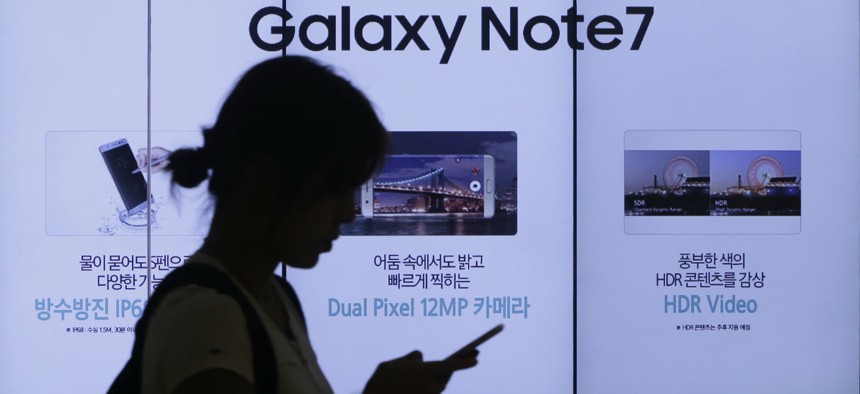Samsung Finally Explained What Caused Galaxy Note 7 Explosions

Ahn Young-joon/AP File Photo
The company claims engineering—not mismanagement—was to blame.
Samsung would like you to believe engineering—not mismanagement—were what caused its phones to explode.
Today, the South Korean tech giant finally revealed the origins of the Galaxy Note 7 explosions that happened last summer during a live-streamed press conference in Seoul. The company gave detailed explanations of the technical issues that led to the malfunctions. But consumers who feel aggrieved by the company will likely be left unsatisfied.
Koh Dong-jin, president of Samsung Electronics’ mobile communications division, took to the stage at the event explaining the company worked with two battery suppliers to make the batteries inside the Galaxy Note 7. Both battery types malfunctioned, however, causing the devices to smoke or explode.
Batteries from “Company A” malfunctioned because of a design issue, Samsung said. It did not name the suppliers in the presentation, though it is likely Company A refers to Samsung SDI—whose batteries were fitted in phones shipped to the U.S. and most other countries. The negative electrode components in the upper-right corner of the battery deflected, leading to a short circuit, Samsung said.
Batteries from “Company B”—likely ATL, a third-party battery vendor that supplied phones shipped to China—malfunctioned because of manufacturing issues. During welding, bumps formed that poked through barriers in the battery and made direct contact with the negative electrode.
After explaining the causes of the explosions, Koh brought on three independent researchers from three third-party testing companies—UL, Exponent, and TUV Rheinland AG—to present their findings after conducting their own studies on the Galaxy Note 7’s batteries. All three confirmed the results of Samsung’s internal investigation.
Koh added Samsung will introduce an eight-step procedure on future phones to ensure similar incidents won’t happen again.
For consumers curious about the technical causes of the explosions, Samsung’s explanation will likely satisfy. What was missing? A sense of remorse.
The Galaxy Note 7 explosions mark one of the largest-ever fiascos for a hardware company in recent memory. Samsung issued formal recalls for the phones not once, but twice. It lost billions of dollars in potential profits. And for some consumers, the incident eroded trust in the Samsung brand.
Koh opened his speech by bowing and expressing his regret for the incident.
“I deeply apologize to all of our customers, carriers, retail and distribution partners, and all of our business partners. We thank you for your patience and continuous support,” he said.
But beyond that, most of his time was spent going over the finer points of battery technology, rather than emphasize its responsibility in shipping dangerous phones to consumers all over the world. His refrains all related to how much time and resources Samsung put into recovering from the fallout—for example, how it utilized 700 people internally to investigate the explosions, or collected 96 percent of the shipped devices.
Meanwhile, other questions surrounding the explosions remain unaddressed. For example, the company didn’t explain why it initially stated some phones were exploding because of “external factors” rather than battery issues. It’s also not clear how Samsung’s new testing procedures measure up to standards set by rival smartphone makers. As there was no Q&A session at the end of the conference, the company gave reporters attending the session no opportunity to probe deeply.
Some observers say Samsung’s conclusions point to deeper management problems within the company.
“It sounds so odd that two separate vendors would create smoking phones from different batteries and with different causes,” says Geoffrey Cain, who has written a soon-to-be published book about Samsung. “There must be a bigger factor in Samsung’s ‘house,’ its structure or management practices.”
Bryan Ma, an analyst at research firm IDC based in Singapore, says the company did the “bare minimum” for addressing its errors. While he lauded the company’s thorough description of the engineering issues that caused the explosions, he added the company could have gone further to show it was working to win back consumers’ trust.
“My worry is that… there’s a still a whiff that this can still happen again,” he says. “I didn’t feel that human touch. ‘We really care’—that’s the message that I felt disappointed we didn’t hear.”
In September, Bloomberg reported a mad rush to compete with the iPhone 7, which was set to be released one month after the Galaxy Note 7’s U.S. launch date, led to Samsung’s oversight of the battery issues. The piece alleged a toxic corporate culture—enabled by de facto leader Lee Jae-yong’s loose grip on the company—caused the mishap.
But investors thus far remain unperturbed by the Galaxy Note 7 fiasco. Shares of Samsung Electronics soared as the explosions occurred, and they continue to hover at those heights months later. Yet, the company must also weather Lee’s embroilment in a national corruption scandal, as well as the upcoming launch of the Galaxy Note 8, which will mark the ultimate test to determine if consumers have abandoned the brand. The company announces its fourth-quarter and full-year earnings tomorrow.





